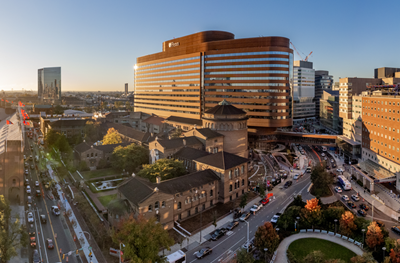
PHILADELPHIA – Marking a historic milestone for Philadelphia and beyond, Penn Medicine officially opened the doors of its 1.5 million-square-foot future-ready Pavilion on Saturday, as clinical staff transported 347 patients from the Hospital of the University of Pennsylvania (HUP) into the new facility.
The 17-story building on Penn Medicine's West Philadelphia campus, which houses 504 private patient rooms and 47 operating rooms, is an expanded footprint of HUP. The Pavilion houses inpatient care for cardiology and cardiac surgery, medical and surgical oncology, neurology and neurosurgery, and transplant surgery, and it is home to HUP's new emergency department.
At 7 a.m., the Pavilion's two-floor Emergency Department (ED) — which has replaced HUP's existing ED — opened. A massive operation to safely transport patients across indoor bridges and tunnels connecting HUP to units at the Pavilion began at 9 a.m. and extended throughout the day, made possible by years of planning and the coordinated assistance of staff members and hundreds of volunteers. A celebratory ribbon-cutting occurred at 8:30 a.m. with University and health system leaders, including Penn President Amy Gutmann and HUP CEO Regina Cunningham, PhD, RN.
The Pavilion is poised to serve as a launch pad for Penn Medicine's next generation of pioneering advances in patient care, according to Kevin Mahoney, CEO of the University of Pennsylvania Health System.
"It's a thrilling time to be part of Penn and our broader Philadelphia community, and we are truly honored to be part of such a dramatic and positive change, as we celebrate the opening of the Pavilion," Mahoney said. "This new building now stands as a testament to Penn's mission to serving humanity — from West Philadelphia to the East Coast, and beyond. The team who designed, built, and now cares for patients in the Pavilion has shown us what the future of medicine looks like and ensured that Penn will be the epicenter of the very best care for generations to come."
The $1.6 billion facility — the culmination of years of planning and construction — represents the latest piece of a connected medical campus, which includes HUP, the Perelman Center for Advanced Medicine for outpatient care, and the Smilow Center for Translational Research. It is the largest capital project in the University of Pennsylvania's history, the largest hospital project in the Philadelphia region, and one of the largest in the United States.
Features of the Pavilion include:
- A "reinvented" Emergency Department designed to decrease wait times, speed diagnosis, and improve the care experience.
- Hybrid operating rooms that enable surgeons and physicians to work side-by-side and perform image-guided surgeries with greater precision.
- An advanced epilepsy monitoring unit (EMU) and a human neurophysiology research lab, which will bring neuroscience research and neurological care closer together.
- IRIS — a 75-inch screen and smart board — installed in every patient room allows patients to review imaging and key information about their care with their physicians, nurses, and other providers. Through IRIS, patients also have greater control of their environment at their fingertips for lighting, shades, temperature, and more, so they can personalize the room to their comfort.
The state-of-the-art Pavilion was designed with the future in mind, and as advances in medicine evolve, so will the building, says J. Larry Jameson, MD, PhD, executive vice president of the University of Pennsylvania for the Health System and dean of the Perelman School of Medicine.
"Thanks to the work of a great team, we are primed for a remarkable transformation of the way we care for patients," Jameson said. "We aim to do nothing less than redefine health care for the people who count on us every day."
Design and planning for the Pavilion was orchestrated by PennFIRST, an integrated project delivery team comprised of Penn Medicine employees, health care design firm HDR, architect Foster + Partners, engineering firm BR+A, and construction managers L.F. Driscoll and Balfour Beatty, among others. The multilayered Pavilion design process used behavioral research to guide design choices at each step, including input from thousands of employees, who paved the way for the Pavilion through a series of life-size mockups of clinical spaces and simulations that could test design assumptions and incorporate feedback.






